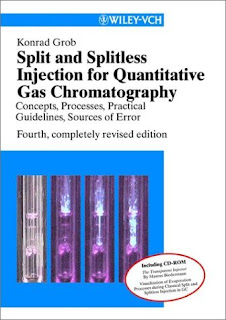by: Konrad Grob

comprehensive and unique handbook of split and splitless injection techniques has been
completely revised and updated. This new edition offers:
New insights concerning sample evaporation in the injector Information about matrix effects A new chapter on injector designThe real processes within the injector are for the first time visualized and explained by the
CD-ROM
completely revised and updated. This new edition offers:
New insights concerning sample evaporation in the injector Information about matrix effects A new chapter on injector designThe real processes within the injector are for the first time visualized and explained by the
CD-ROM
included in the book. Furthermore the reader will understand the concepts of injection
techniques and get a knowledge of the sources of error. The handbook also includes many
practical guidelines. From reviews of former editions:"This substantial book is on injection techniques alone, which...demonstrates this can have many
pitfalls...no one should be allowed to direct a laboratory doing quantitative analysis by GC
without first being thoroughly familar with this book..." --The Analyst
"This is a detailed reference volume filled with practical suggestions and techniques for
managing split and splitless injection in the day-to-day world of the working gas
chromatographer. It will be useful...for anyone who must work hands-on with GC." --Journal of
High Resolution Chromatography
Table of Contents
SYRINGE INJECTION INTO HOT VAPORIZING CHAMBERS.
techniques and get a knowledge of the sources of error. The handbook also includes many
practical guidelines. From reviews of former editions:"This substantial book is on injection techniques alone, which...demonstrates this can have many
pitfalls...no one should be allowed to direct a laboratory doing quantitative analysis by GC
without first being thoroughly familar with this book..." --The Analyst
"This is a detailed reference volume filled with practical suggestions and techniques for
managing split and splitless injection in the day-to-day world of the working gas
chromatographer. It will be useful...for anyone who must work hands-on with GC." --Journal of
High Resolution Chromatography
Table of Contents
SYRINGE INJECTION INTO HOT VAPORIZING CHAMBERS.
Introduction.Syringes.Evaporation Inside the Needle.How Much is Really Injected?Syringe Needle Handling Minimizing Discrimination.Dependence of Discrimination on Sample Volume.Solvent and Solutes.Injector Temperature.Plunger-in-Needle Syringes.Possibilities of Avoiding Evaporation in the Needle.Summarizing Guidelines.
SAMPLE EVAPORATION IN THE INJECTOR.
SAMPLE EVAPORATION IN THE INJECTOR.
Introducton.Solvent Evaporation - Heat Transfer.Solvent Evaporation - Visual Observation.Solute Evaporation.Sample Degradation in the Injector.Retention and Adsorption in the Vaporizing Chamber.Deactivation of Liners and Packing Materials.Cleaning of Injector Liners.
SPLIT INJECTION
SPLIT INJECTION
.Introduction.The Split Ratio.Sample Concentrations Suitable for Split Injection.Initial Band Widths.Split Injection for Fast Analysis.Analysis Requiring Maximum Sensitivity.High Split Ratios for Reducing the Sample Size.Problems Concerning the Split Ratio.Problems Concerning Linearity of Splitting.Techniques for Improving Quantitative Analysis.General Evaluation of Split Injection.
SPLITLESS INJECTION.
SPLITLESS INJECTION.
Introduction.How to Perform Splitless Injection.Sample Volumes Suitable for Splitless Injection.Injection of Large Volumes.Sample Transfer into the Column.Problems with Quantitative Analysis.Reconcentration of Initial Bands.Related Injection Methods.General Evaluation of Splitless Injection.
INJECTOR DESIGN.
INJECTOR DESIGN.
Vaporizing Chamber.Surroundings of the Vaporizing Chamber.Autosamplers.The Gas Regulation Systems.
Appendix 1: Selection ofthe Injection Technique.Appendix 2: Selection of Conditions for Classical Split and Splitless Injection.Appendix 3: Glossary of the Most Important Terms Used in the Text.Subject Index
Appendix 1: Selection ofthe Injection Technique.Appendix 2: Selection of Conditions for Classical Split and Splitless Injection.Appendix 3: Glossary of the Most Important Terms Used in the Text.Subject Index
Download
0 comments:
Post a Comment